
Xiang Yi, graduated from Henan University majoring in museology, and postgraduate of Inner Mongolia Normal University, with a master degree in historical philology. Museologist of the Research Department of Henan Museum.
Apart from the writing brush washer and the traditional Four Treasures of the Study (writing brush, ink stick, paper, and ink-slab), can you name other articles for the study?
Your answer please, if you have any questions or answer, please feel free to send us email, we are waiting for your answers and participation, and your comments, answers and suggestions will be highly appreciated. We will select and publicize the most appropriate answers and comments some time in the future.
Weekly Selection Email: meizhouyipin@chnmus.net
The Four Treasures of the Study
Writing brush, ink stick, paper and ink-slab are writing implements unique to China. Since the Song Dynasty, the "Four Treasures of the Study" has specifically referred to Hu writing brush, Hui ink stick, Xuan paper, and Duan ink-slab.
Hu writing brushes, which are made in Huzhou, Zhejiang Province, are characterized by a neat and transparent tip. They are acclaimed as the very best of all kinds of writing brushes.
The use of ink can be dated back to the late Neolithic Age, when natural ink was used for writing. Man-made ink appeared around the reign of King Xuan of Zhou. During the Southern Tang Dynasty, Li Tinggui invented the most famous kind of ink of the time. During the Song Dynasty, the origin of "Li ink", Shexian, was renamed Huizhou. After that, the name Li Ink was changed into Hui Ink.
Xuan paper is produced in Jingxian County, Anhui Province, which used to be under jurisdiction of Xuanzhou. It is white and fine, smooth but not glossy, with clean and neat grains. Moreover, it has a very long life and can be folded numerous times without getting worn, for which it is called 'thousand-year paper'.
Duan ink-slabs specifically refer to those produced in what is now Zhaoqing in Guangdong Province, which used to be named Duanzhou. They are made of hard, fine and smooth stones, so that ink can be quickly produced from effortless grinding of ink slabs on them. Because of this, they have been highly favored by scholars and rank first among the four most famous kinds of ink-slabs.
Notes:
[1] Yao Silian (Tang Dynasty). Book of Liang [M]. Zhonghua Book Company, 2000.
[2] Du Mu (Tang Dynasty]. 奉和门下相公送西川兼领相印出镇全蜀 [M]/Complete Tang Poems (vol. 521). Zhonghua Book Company, 1960.
[3] Su Yijian (Song Dynasty). Wen Fang Si Pu [M]. Chongqing Publishing Group, Chongqing Press, 2010.
[4] Wen Zhenheng (Ming Dynasty). Chang Wu Zhi [M], in the Chinese Artistic Literature Series. Zhejiang Publishing United Group & Zhejiang People's Fine Arts Press, 2011.
[5] Gao Lian (Ming Dynasty). Zun Sheng Ba Jian [M]. Huangshan Publishing House, 2010.
[6] Tu Long [Ming Dynasty]. Kao Pan Yu Shi [M], in the Chinese Artistic Literature Series. Zhejiang Publishing United Group & Zhejiang People's Fine Arts Press, 2011.
Most of the writing brush washers of various types that we can see today were made during the Song, Yuan or later dynasties. The greater part of them dates from the Ming or Qing Dynasty and is more diverse in material.
The Northern Song Ru-Kiln celadon writing brush washer (Fig. 3), now in the collection of the National Museum of China, is 5.2 cm in height, 16.7 cm in mouth diameter, and 13.1 cm in base diameter. Located in what is now Baofeng County, Henan Province, Ru Kiln is one of the five most famous kilns of the Northern Song Dynasty.
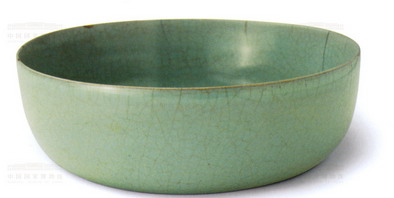
The kidney-bean red glazed writing brush washer made in the Kangxi Period of the Qing Dynasty (Fig. 4), now in the collection of Capital Museum, is 3.7 cm in height. 8.4 cm in mouth diameter, and 8 cm in base diameter. It is shaped like a bowl, with a contracted mouth and a ring base. The inside is covered with white glaze and the outside with kidney-bean red glaze. The bottom bears six blue-and-white Chinese characters meaning "made in the Kangxi Period of Great Qing" in regular script and three rows.
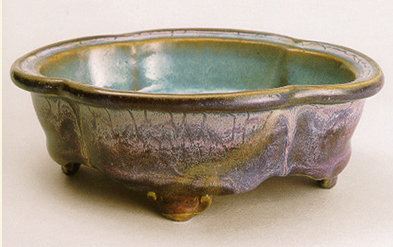
The Hindustan white jade petal-shaped writing brush washer made in the Qianlong period of the Qing Dynasty (Fig. 5), now in the collection of the Palace Museum, is 5.5 cm high with the mouth measuring 15.5 X 12 cm and the base measuring 8.4 X 6.2 cm. It is in the shape of Chinese crabapple petals and the ears are decorated with flower leaves. At the bottom is a ring base.
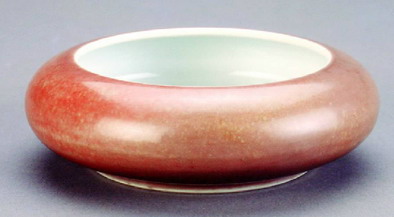
The peach-shaped blue jade writing brush washer with relief carvings made in the Qianlong period of the Qing Dynasty (Fig. 6), now in the collection of Henan Museum, is 5.9 cm high, 9.5 cm wide, and 15.5 cm long. Made of blue jade, it is shaped like an irregular peach and has a contracted mouth. The belly and the bottom are carved with peach twigs and leaves as well as two bats, which carry the symbolic meaning of "happiness and longevity".
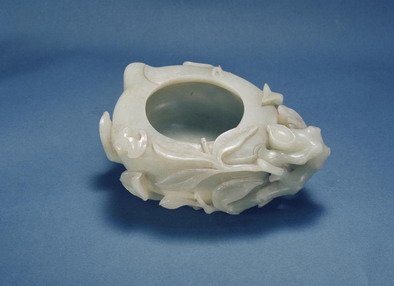
Though the use of writing brush washers remained essentially the same through various historical periods, their form and design reflect different features of the times. This lotus-shaped blue-and-white writing brush washer with Sanskrit inscription in the collection of Henan Museum is one of the artifacts reflecting the belief in Buddhism during the Ming Dynasty. Sanskrit was introduced to the east along with Buddhism and enjoyed an enduring popularity during the Ming Dynasty, when Sanskrit words and the lotus became common decorative subjects on various kinds of articles. The fact that writing brush washers for daily use by Confucian scholars were decorated with Sanskrit words and lotuses reflects the prevalence of Buddhism during the Ming Dynasty.
Writing brush washers, which were used in the study, are vessels containing water for washing writing brushes. Most of them are made of porcelain, though some can be made of jade, agate, enamel, ivory or rhinoceros horn. They are usually shaped like a bowl, though some can be rectangular, sunflower-shaped or peach-shaped. As objects on display in the study, they are of ornamental and artistic values apart from their practical use.
Ornaments for the study (wenfang) are also known as "miscellaneous articles for the study" or "amusing articles for the study". The Chinese word wenfang first appears in the "Biography of Jiang Ge" in Book of Liang: "The imperial college has shown great discernment in admitting the Wang brothers and appointing them to posts in the wenfang. This is like harnessing two dragons for a long journey or riding fine steeds for a thousand miles. [1]" Here wenfang refers to the state office in charge of official documents and correspondence at the time. During the Tang Dynasty, wenfang was understood as the study of a member of the literati. The word was used by Du Mu in one of his poems: "Red bows in the arsenal/And gold seals in the study (wenfang)" [2].
During the Sui and Tang Dynasties, with the introduction and flourishing of the imperial examination system and the consequent growth in the number of the literati, there appeared a great variety of implements for the study, which went far beyond the traditional categories of writing brush, paper, ink stick and ink-slab.
During the Song Dynasty, ornaments for the study became of interest to collectors. Zhao Xigu in the Southern Song Dynasty was the first one to write a systematic treatise on articles for the study. In particular, the book Wen Fang Si Pu[3] (literally “Four Treatises on Articles for the Study”), written by Su Yijian in the Southern Tang Dynasty, marked the beginning of the popularity of such ornaments.
Having been popularized and diversified during the Song and Yuan Dynasties, articles for the study came into a golden age during the Ming Dynasty. In the volume entitled "articles and implements" in the book Chang Wu Zhi (literally "Treatise on Superfluous Things")[4], Wen Zhenheng listed a number of such articles, including ink-slabs, writing brushes, ink sticks, paper, brush racks, brush holders, brush screens, brush pots, brush boats, brush washers, brush smoothers, and shuizhongcheng (small water containers for ink-slab). Besides, in Zun Sheng Ba Jian (literally “Eight Discourses on the Art of Living”) [5] by Gao Lian of the Ming Dynasty, there is a chapter dedicated to all kinds of interesting articles for the study. Among all the books about such articles written by Ming scholars, 49 categories, the largest number, can be found in Kao Pan Yu Shi (literally “Desultory Remarks on Furnishing the Abode of the Retired Scholar”) [6] by Tu Long.
The Qing scholars were even more enamored with ornaments for the study, carrying the Four Treasures of the Study and their supplementary instruments to the extreme of ingenuity so that they became "amusing" indeed.
This lotus-shaped blue-and-white writing brush washer with Sanskrit inscription is a valuable piece of porcelain dating from the reign of Wanli during the Ming Dynasty. It witnessed a political scandal in the modern history of China, in which one of the Northern Warlords Cao Kun bribed Yang Yunsheng, a senator of the Beijing government then, with silver dollars and this writing brush washer in hope of becoming the president. After the founding of the People's Republic of China, Yang's descendants donated the brush washer to the state.
The Ming lotus-shaped blue-and-white writing brush washer with Sanskrit inscription marked with the reign title of Wanli (Fig. 1) was obtained by Henan Museum through public solicitation. It has a height of 5.5 cm, a mouth diameter of 19 cm, and a base diameter of 11.8 cm. It is fully covered with exquisite designs in deep blue, and the glaze is smooth and shiny. As a whole it is shaped like a lotus flower in full blossom. It has a ring base adorned with double layers of bow-string patterns, in which are the words "made in the Wanli reign of the Great Ming" in regular script (Fig. 2). This is a masterpiece made at the kiln in Jingdezhen during the Ming Dynasty.
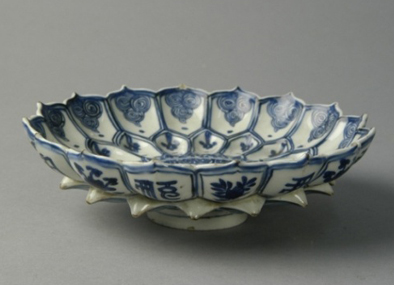

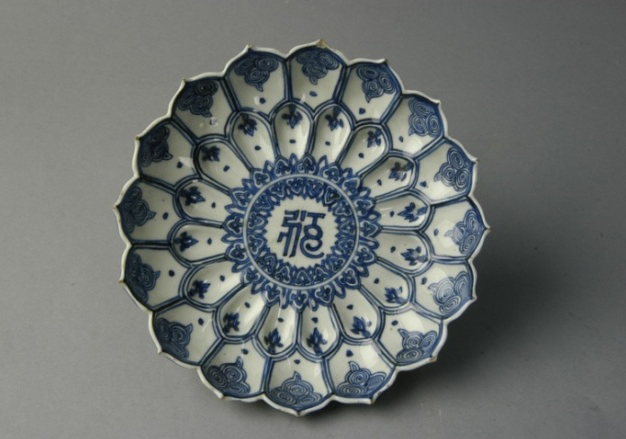
Title: Lotus-shaped Blue-and-white Writing Brush Washer with Sanskrit Inscription
Medium: Ceramic
Period: Ming Dynasty
Measurements: H.5.5cm; Mouth Dia. 19cm; Base Dia. 11.8cm
Provenance: Gift from the public